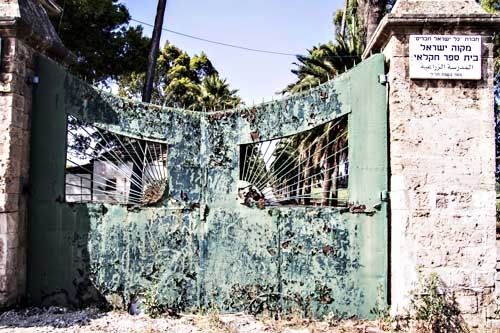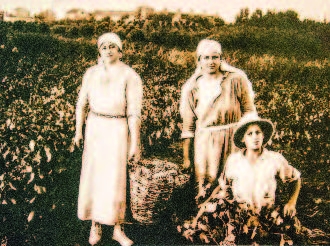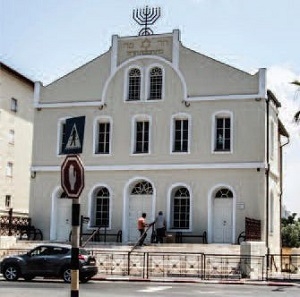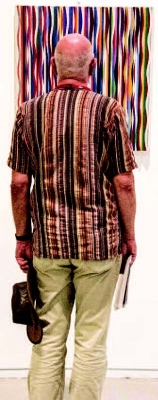Gateway to a City Surprises
Our group of ESRA explorers from Netanya, joined by a few more from Herzliya, set out recently on another journey through time. As always we were led by our intrepid leader, Scottish lawyer turned Israeli tour guide, Stephen Kliner, who kindly donates his services to ESRA. Thank you also to Michael Tucker, Bish Ben Ezra and Michael Altman, our organizers.
This time we were on our way to Rishon Lezion – From the Early Pioneers to The Agam Art Museum, with a few surprises on the way, as we have come to expect from Stephen.
Our first surprise stop was at Mikve Israel (Hope of Israel).
We stood on a path at the side of Route 44, with cars whizzing past us, outside what was once the main entrance gate to Mikve Israel. Stephen told us the history of this place beyond the beautiful gates, which open up onto to a wide boulevard of palm trees. It was at this entrance Herzl first met Kaiser Willhelm II in 1898. Established in 1870, it was the first Jewish agricultural school in Palestine, built twelve years before the First Aliyah. Today it is still a youth village and boarding school. Jews landing in the Port of Jaffa came here first to learn how to work the land. To this day nothing else can be built on this land.
This school, which was part of the effort and courage of the first pioneers to settle and develop the land, was an important part of all that we see around us now and yet few of us ever notice it as we drive past!
Our next stop was at the Rishon LeZion Open Air Museum situated in Old Rishon.
Rishon LeZion is now the fourth largest city in Israel with a mix of old and modern. It was founded by seventeen pioneer families, part of a small group from the Hovvei Zion (Lovers of Zion) movement. They arrived on 31st July 1882, from Eastern Europe, fleeing the pogroms of 1881 in the Ukraine and Southern Russia. They came with the ideal to establish a Jewish agricultural settlement and to found a new society in Eretz Yisrael for the Jews.
The Open Air Museum was founded in 1982, a hundred years after the founding of Rishon. We toured five of the oldest restored homes from the First Aliyah Period (1882 – 1904). We saw some of the unique historical and cultural contributions of this settlement (moshava) and how they lived. We saw photos of their lives here, their families, and the equipment they used and made to farm the land. This was the beginning of modern Zionism, the first modern Jewish colony established in the ancient land of Israel.
In 1850 Palestine was part of the Ottoman Empire. Most of the land had not been farmed for hundreds of years, and was leased by tenant farmers from absentee landlords living in Beirut. The Sultan made the people register their land (tabu) for the first time. There were people who said they would register the land for the absentee landlord but then registered the land in their own names! You then have two landlords and had to pay twice.
Zalman David Levontin and Joseph Feinberg were two of the founding fathers of Rishon. They had formed the organization, Yesod Ha'maala Pioneers in order to purchase land to establish independent Jewish agricultural settlements. They bought 3,340 dunams of land known as "Ayun Kara" from an Arab family. The families named the new settlement Rishon LeZion. The name is based on the biblical passage in Isiah 41:27: "We are the first to Zion and will bring good tidings to Jerusalem."
They settled on a hill and tried to grow wheat and barley, but they had no water. After only two weeks a committee was formed to decide what to do. They sent Joseph Feinberg to Europe to solicit funds and to help them to buy the tools necessary to continue digging a well. He found Baron Edmond De Rothschild who wanted to help. He sent 25,000 francs. The Baron also sent managers to see what the best crops were to grow, and helped them for seventeen years.
After the museum, on our walk down the main road of Old Rishon to The Village Well, we saw the first buildings of the town and the first Hebrew Elementary School, where all the subjects were taught in Hebrew for the first time in 2,000 years. We saw the first synagogue where they prayed in the Ashkenazi format. The Sephardi Jews were told to pray after the Ashkenazi service. They did not like this so they built their own synagogue in someone's backyard. Nothing new under the sun!
At The Village Well we saw the actual well, and a film re-enacting the finding of the water on February 23rd 1883, 48 meters down. It was fascinating.
Rishon was where Hatikvah was composed, and our blue and white national flag created. The first Hebrew Orchestra started here in 1895. Here women obtained equal voting rights for the first time in 1917. The KKL-JNF was conceived in Rishon.
After a short break for lunch we visited the magical, amazing phenomenon that is the Yaacov Agam Museum of Modern Art.
It is built in one of the new suburbs of Rishon, as if Yaakov Agam wanted to make the museum part of the everyday lives of the inhabitants of Rishon, his childhood home : "Change is the most permanent element of reality."
We were taken round the museum by a guide who helped us understand step by step what Agam's paintings are telling us. To really understand his art you have to go and participate and experience his art.
Yaakov Agam was born Yaakov Gibstein on May11th, 1928 in Rishon LeZion. His father was a rabbi and a Kabbalist. He grew up in a family steeped in Jewish spiritual values. He says Jews are different. We do not have any physical objects like idols to show our faith. There are no "graven" images in his works. His goal is to glorify the power of Jewish thought in his art. He didn't do well at school and spent much of his youth exploring the changes of nature like the sand dunes of Rishon that change constantly with the blowing of the wind. He says because he didn't study in a formal way doesn't mean he doesn't know. He believes the visual is more important than the verbal. The visual is our primary language. It is just as important to learn how to see as it is to learn how to think.
He is the father of The Kinetic Movement in Modern Art, which is the real or imagined movement of shapes in space over time. He says this theory is based on Jewish belief, which is built on an emerging reality. His works are ever changing.
The visual is polymorphic, that is, it can occur in different forms, as the Kabbalah deals with the spheres beyond our ordinary physical life. We saw transformable sculptures, polymorphic relief paintings, and interactive digital art. In his art he asks you to see "beyond the visible". Art reflects reality, it is a constant "becoming" where the most important aspect is change. We feel we become part of the ever changing artworks. We become part of the 4th dimension – the dimension of time and movement, change and the unexpected – you yourself can cause the change!
His paintings are a moving, ever changing experience. As you approach a painting and walk from one side to the other, or actually move the painting or sculpture you are part of the spectacle of change.
The words Art and Faith come from the same Hebrew root אומן-artist and אמונה-faith. Agam wants to teach the younger generation his philosophy of life, and uses his museum to have workshops for children to experience his way of seeing. It was a truly thought provoking, exciting experience.
Stephen doesn't give up easily! We were supposed to have visited The Memorial Park in Rishon earlier on in the day but were running late. As we boarded the bus for what we thought was our trip back home Stephen said he had one more surprise. One more stop, even though we were all now running on fumes. The Memorial Park. It really was a perfect ending to a perfect day. We saw a few of the many thought provoking sculptures situated amongst the trees and lawns of this beautiful park.
Perhaps this is the message we all carried away with us that day. We owe so much to so many courageous people who followed their dreams and stood up for their ideals. Just as today Yaakov Agam stands up for what he believes. They helped to create the miraculous country we live in.












Comments